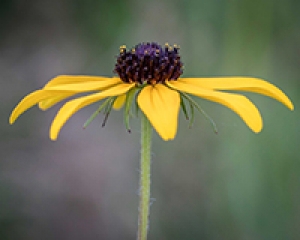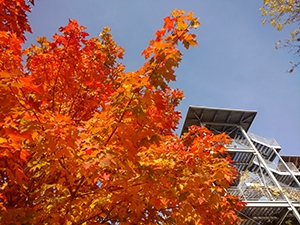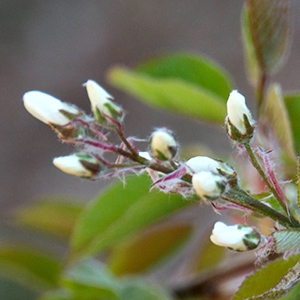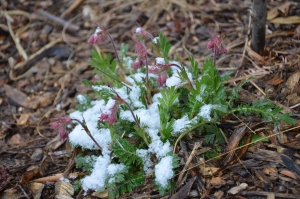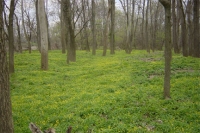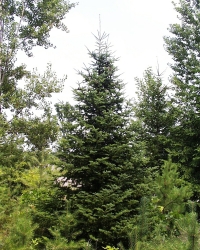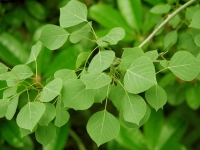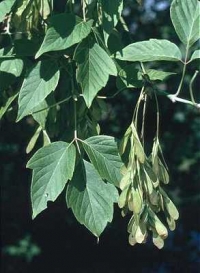

Caitlin Reinartz
Caitlin Reinartz is the Forester at the Urban Ecology Center Riverside Park branch, working primarily on the Milwaukee Rotary Centennial Arboretum. She attended the University of Wisconsin-Madison and studied Forest Management. Caitlin is a firm believer that Wisconsin is the best and most beautiful state in the union. She spent her childhood playing outside, and was inspired to work to preserve our region’s natural areas during camping trips to the Boundary Waters Canoe Area Wilderness when she was in middle and high school.
Plant Anatomy & Physiology Course
When I first started learning about plants, I had a lot of questions. How does a tree gets water from deep in the ground all the way up to leaves 160 feet in the air? How are plants able to survive cold winters like this one? How do seeds know when to germinate in the spring? Why are most plants green anyway? Why not blue or pink or black? Do plants communicate with one another? How do plants defend themselves from attack by insects? Whew! That's a lot of stuff to learn! The more I dug into this (no pun intended), the more I discovered how amazing, adaptable, and beautiful plants can be.
Fall Colors: Behind the Scenes
It’s officially autumn! Time for pumpkins and sweaters and soaking up every moment of sunshine before winter hits. Fall is such a wonderful time of year. The entire forest turns into a spectacle of color and light — a showy and powerful promise from Mother Nature that if we huddle through these few cold months, she’ll be back and better than ever. Walking through the woods in fall, with a crisp silent breeze and only the sound of feet through dry leaves, one might think that the forest seems to be settling down for a big nap.
From the perspective of a tree, though, fall is an incredibly busy season.
False Spring: How Plants React to Unseasonal Warmth
Coming from the perspective of a human (a true biological juggernaut of adaptability), the past couple of weeks have been a real joy. For a few glorious days, I wore a tank top outside at work (in February!) and today I’m walking in a winter wonderland again. While the particular weather pattern we’ve just experienced here in Milwaukee has been a treat for us humans, for the plants around us, trees and shrubs especially, it will prove to be more of a trial.
I See a Transformation
It was a crisp September morning, the end of the first growing season for the Milwaukee Rotary Arboretum. I was with a group of volunteers, keeping the weeds at bay. Hunched over and intent on my work, I would have missed it if a large shadow hadn't passed over the ground in front of me. I looked up and saw the last thing I ever thought I would see in the heart of Milwaukee – a bald eagle!
Overwintering Plants: Science and Practice
Winter is on its way, and I'm preparing by unearthing the wool socks and long johns buried in the back of my closet, and by covering my windows with plastic (one of my least favorite chores). All this preparation makes me think of my little plant friends, who are also busy preparing for winter in their own way. How can a living thing freeze solid for months, then thaw out the next spring and continue on its merry way? And how can we humans help prepare our plants for their big sleep? Read on to learn how plants get ready for winter, and how we’ve successfully overwintered plants in our nursery here at the Center for the past 8 years!
Invasive Plant To Watch: Lesser Celandine (Ranunculus ficaria)
The story of lesser celandine (also known as fig buttercup or pilewort) is the classic story of an invasive species. Native to Europe, northern Africa, western Asia, and Siberia, it was brought to the United States as an ornamental plant. While here, this species found that it had a huge competitive advantage and it took over. In Cleveland, Ohio, lesser celandine was planted in flower beds of (just) two residences in the 1970s. It escaped the confines of those two yards, and less than 40 years later, it had taken over nearly 300 acres of parkland along the Rocky River, with 183 of those acres having lesser celandine cover of more than 50% (that means that lesser celandine covered more than half of the ground, leaving little room for native vegetation).
Native Tree Spotlight: Balsam Fir (Abies balsamea)
Living in Wisconsin, one can expect winters to be cold. Well, these last few days of frigid temperatures have tested even the hardiest Wisconsinites. I for one have been thanking my lucky stars for my fleece long johns and my wool sweaters, and I’ve been drinking more than my fair share of hot tea and coffee. Looking out of my window at our winter wonderland, I can’t help but wonder how our animal friends manage to keep themselves warm through the cold winter months. As we know, some hibernate, some migrate, and some don’t make it through the winter. Those that do stick around and survive make use of our coniferous trees for thermal cover and food. This month’s Native Tree Spotlight revolves around one of our more important wildlife cover trees, the balsam fir (Abies balsamea).
Fall Colors: How and Why?
I recently read Matt Flower’s awesome post entitled “The Beauty of Fall Trees” where readers got a great overview of the magic of fall colors. After reading his post and looking at his stunning photos, I got excited to do a “piggy-back post” about the science behind autumn colors. Read on to find out more about what changes trees undergo in the fall: why do leaves turn colors? How do they change color? Why do individual trees change to certain colors while others change to a completely different color?
Native Tree Spotlight: Quaking Aspen
This month we turn the spotlight onto a native tree that has a large and dedicated fan base, the quaking aspen (Populus tremuloides). Its fan base consists of hunters, recreationists, bunches of wildlife, and me! The trees have smooth pale bark scarred with black. The leaves are almost circular to triangular with little teeth all the way around the edge. They are glossy and green above, a dull whitish color on the underside, and turn a beautiful golden yellow in the fall. The petioles or leaf stalks are flattened instead of round, which causes the leaves to flap and flutter beautifully in the wind, hence the name “quaking” aspen.
Native Tree Spotlight: In Defense of Box Elder
I talk to a lot of people about trees. Those conversations are about identification, physiology, or growth habit, but my favorite conversations about trees are ones about how awesome or beautiful a certain tree or species of tree is. During these talks I have noticed that most folks are not as willing to sing the praises of box elder (Acer negundo).The following is an admittedly overly-impassioned plea for the love of this month’s native tree, the lowly box elder.
Copyright © 2023 The Urban Ecology Center

